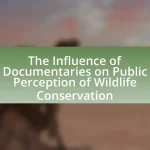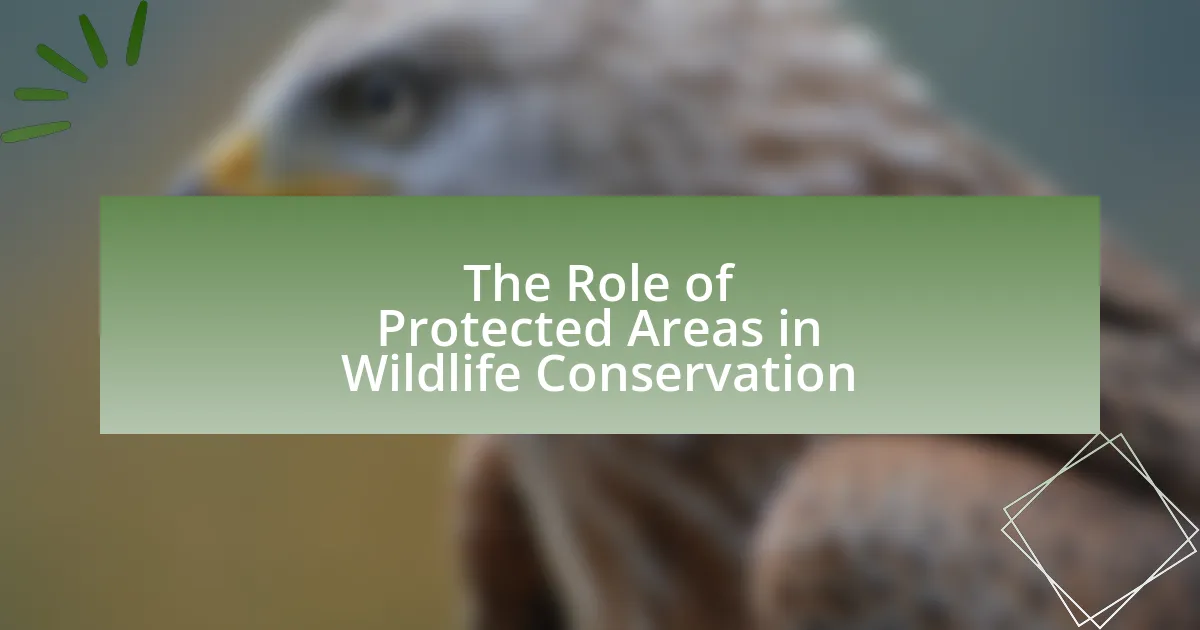Wildlife corridors are critical areas that connect fragmented habitats, enabling safe animal movement and promoting biodiversity. This article examines the importance of wildlife corridors in maintaining genetic diversity, facilitating species migration, and enhancing ecosystem resilience. It discusses the challenges these corridors face, including habitat fragmentation and human encroachment, and outlines methods for assessing their effectiveness, such as monitoring animal movement and genetic diversity. Additionally, best practices for designing effective corridors and lessons learned from existing projects are highlighted, emphasizing the role of community involvement in successful corridor implementation.

What are Wildlife Corridors and Why are They Important?
Wildlife corridors are designated areas that connect fragmented habitats, allowing animals to move safely between them. These corridors are crucial for maintaining biodiversity, as they facilitate gene flow among populations, reduce the risk of inbreeding, and enable species to access resources such as food and mating opportunities. Research indicates that wildlife corridors can significantly enhance the survival rates of various species; for example, a study published in the journal “Ecological Applications” found that corridors increased the movement of small mammals by 50%, demonstrating their effectiveness in promoting wildlife connectivity.
How do Wildlife Corridors function in ecosystems?
Wildlife corridors function in ecosystems by providing safe passage for animals between fragmented habitats, thereby enhancing genetic diversity and population stability. These corridors mitigate the effects of habitat fragmentation caused by human activities, such as urban development and agriculture, which can isolate animal populations. Research indicates that wildlife corridors can significantly increase the movement of species, as demonstrated in studies like the one conducted by Beier and Noss (1998), which highlighted the importance of connectivity for maintaining biodiversity. By facilitating animal migration and dispersal, wildlife corridors play a crucial role in ecosystem resilience and health.
What species benefit from Wildlife Corridors?
Wildlife corridors benefit a variety of species, including large mammals like bears, wolves, and deer, as well as smaller animals such as amphibians and reptiles. These corridors facilitate safe movement between habitats, reducing the risks of inbreeding and allowing access to resources. Research indicates that species such as the Florida panther have shown increased genetic diversity due to the establishment of wildlife corridors, which is crucial for their long-term survival. Additionally, studies have demonstrated that migratory birds utilize these corridors to navigate between breeding and wintering grounds, enhancing their chances of survival and reproduction.
How do Wildlife Corridors facilitate animal movement?
Wildlife corridors facilitate animal movement by providing safe passageways that connect fragmented habitats. These corridors enable species to migrate, find food, and mate, which is essential for maintaining genetic diversity and population stability. Research indicates that wildlife corridors can significantly reduce roadkill incidents and enhance species survival rates, as demonstrated in studies like the one conducted by the University of California, which found that animals using corridors had a 50% higher survival rate compared to those that did not.
What challenges do Wildlife Corridors face?
Wildlife corridors face several significant challenges, including habitat fragmentation, human encroachment, and climate change. Habitat fragmentation disrupts animal movement and reduces genetic diversity, as species become isolated in smaller areas. Human encroachment, such as urban development and road construction, further limits access to these corridors, increasing the risk of wildlife-vehicle collisions. Climate change alters ecosystems and can shift species distributions, making existing corridors less effective. Studies indicate that over 50% of wildlife corridors are impacted by these factors, highlighting the urgent need for effective management strategies to ensure their functionality.
How does habitat fragmentation impact Wildlife Corridors?
Habitat fragmentation negatively impacts wildlife corridors by reducing their effectiveness in facilitating animal movement and genetic exchange. Fragmented habitats create barriers, such as roads and urban developments, which can isolate populations and limit access to essential resources like food and mating opportunities. Studies show that fragmented landscapes can decrease the likelihood of species successfully traversing corridors, leading to reduced genetic diversity and increased vulnerability to extinction. For instance, research published in “Ecological Applications” by Haddad et al. (2015) indicates that wildlife corridors are less effective in fragmented landscapes, as animals are less likely to use them when they are surrounded by inhospitable environments.
What human activities threaten the effectiveness of Wildlife Corridors?
Human activities that threaten the effectiveness of wildlife corridors include urban development, agriculture, and road construction. Urban development fragments habitats, making it difficult for wildlife to navigate between areas. Agriculture often leads to land conversion, reducing the available space for wildlife movement. Road construction creates barriers that can result in wildlife mortality and restrict access to essential resources. Studies have shown that these activities significantly diminish the connectivity that wildlife corridors are designed to provide, ultimately impacting biodiversity and ecosystem health.

How is the Effectiveness of Wildlife Corridors Assessed?
The effectiveness of wildlife corridors is assessed through various methods, including monitoring animal movement, genetic studies, and ecological surveys. Monitoring animal movement involves tracking species using GPS collars or camera traps to evaluate how frequently and successfully they use the corridors. Genetic studies analyze gene flow between populations to determine if corridors facilitate genetic diversity. Ecological surveys assess changes in species richness and abundance in areas connected by corridors compared to isolated habitats. These methods provide concrete evidence of the corridors’ role in enhancing wildlife connectivity and overall ecosystem health.
What methods are used to evaluate Wildlife Corridor effectiveness?
Methods used to evaluate wildlife corridor effectiveness include monitoring animal movement, assessing genetic diversity, and analyzing habitat connectivity. Monitoring animal movement often employs GPS tracking and camera traps to gather data on species using the corridor, providing insights into usage patterns and frequency. Assessing genetic diversity involves collecting genetic samples from populations on either side of the corridor to determine if the corridor facilitates gene flow, which is crucial for long-term population viability. Analyzing habitat connectivity uses landscape ecology metrics to evaluate how well the corridor links fragmented habitats, often employing GIS tools to visualize and quantify connectivity. These methods collectively provide a comprehensive understanding of how effectively wildlife corridors function in promoting species movement and maintaining biodiversity.
How do researchers measure animal movement through corridors?
Researchers measure animal movement through corridors primarily using tracking technologies such as GPS collars, radio telemetry, and camera traps. These methods allow for precise monitoring of animal locations and behaviors as they navigate through designated corridors. For instance, GPS collars provide real-time data on movement patterns, while camera traps capture images of animals, enabling researchers to analyze frequency and timing of corridor use. Studies have shown that these techniques can yield valuable insights into the effectiveness of wildlife corridors in facilitating animal movement, as evidenced by research conducted by Clevenger and Waltho (2005) in “Effects of Wildlife Crossings on the Movement of Large Mammals,” which demonstrated significant increases in successful crossings in areas with established corridors.
What role does biodiversity play in assessing effectiveness?
Biodiversity plays a critical role in assessing the effectiveness of wildlife corridors by serving as an indicator of ecological health and connectivity. High levels of biodiversity within these corridors suggest successful habitat connectivity and species movement, which are essential for maintaining genetic diversity and ecosystem resilience. Studies have shown that wildlife corridors that support diverse species populations are more effective in facilitating animal movement and reducing mortality rates, thereby enhancing overall ecosystem functionality. For instance, research conducted by Beier and Noss (1998) highlights that corridors that maintain or increase biodiversity contribute significantly to the long-term viability of wildlife populations, demonstrating their effectiveness in conservation efforts.
What indicators are used to determine success?
Indicators used to determine success in assessing the effectiveness of wildlife corridors include species movement, genetic diversity, and population stability. Species movement is measured by tracking the frequency and patterns of animal crossings through the corridors, which indicates their usability. Genetic diversity is assessed through genetic sampling, revealing whether corridors facilitate gene flow between isolated populations, thus enhancing resilience. Population stability is evaluated by monitoring population sizes and health over time, ensuring that wildlife populations are maintained or increased as a result of the corridors. These indicators collectively provide a comprehensive understanding of the corridors’ effectiveness in supporting wildlife connectivity and conservation goals.
How is species diversity measured in relation to Wildlife Corridors?
Species diversity in relation to wildlife corridors is measured using metrics such as species richness, evenness, and the Shannon-Wiener index. These metrics assess the variety and abundance of species present in areas connected by corridors compared to isolated habitats. Research indicates that wildlife corridors enhance species diversity by facilitating movement and gene flow, which can be quantified through field surveys and biodiversity assessments. For example, studies have shown that areas with effective wildlife corridors exhibit higher species richness, with specific data indicating a 30% increase in species diversity in connected habitats versus fragmented ones.
What metrics indicate improved animal populations in connected habitats?
Improved animal populations in connected habitats can be indicated by metrics such as increased species richness, higher population densities, and enhanced genetic diversity. Species richness measures the variety of species present, which tends to increase in connected habitats due to reduced barriers to movement. Higher population densities reflect successful migration and reproduction, often observed in areas with effective wildlife corridors. Enhanced genetic diversity results from increased gene flow between populations, reducing inbreeding and promoting resilience, as evidenced by studies showing that connected habitats support larger, more genetically diverse populations compared to isolated ones.

What are the Best Practices for Designing Effective Wildlife Corridors?
The best practices for designing effective wildlife corridors include ensuring connectivity, considering species-specific needs, and incorporating natural landscape features. Connectivity is crucial as it allows wildlife to move freely between habitats, reducing isolation and promoting genetic diversity. Research indicates that corridors should be wide enough to accommodate various species, with widths of at least 100 meters recommended for larger mammals to thrive. Additionally, understanding the behavioral patterns and habitat preferences of target species helps in tailoring corridors to their specific requirements, enhancing their usability. Incorporating natural landscape features, such as vegetation and water sources, further supports wildlife movement and habitat quality. Studies have shown that corridors designed with these elements significantly improve wildlife passage rates and overall ecosystem health.
How can landscape connectivity be enhanced?
Landscape connectivity can be enhanced by creating and maintaining wildlife corridors that facilitate animal movement between fragmented habitats. These corridors can be designed based on ecological data that identifies critical pathways for species, ensuring they connect key habitats and resources. Research indicates that well-planned corridors can significantly reduce wildlife mortality rates and increase genetic diversity by allowing for interbreeding among isolated populations. For example, a study published in the journal “Ecological Applications” by Beier and Noss (1998) demonstrates that effective wildlife corridors can improve species survival rates by up to 50% in fragmented landscapes.
What design features are critical for successful Wildlife Corridors?
Critical design features for successful wildlife corridors include adequate width, connectivity, and habitat quality. Adequate width ensures that animals can move freely and safely, reducing the risk of predation and vehicle collisions. Connectivity between habitats is essential for genetic diversity and population stability, as it allows species to migrate and access resources. High-quality habitat within the corridor, including native vegetation and water sources, supports the needs of wildlife, enhancing their chances of survival. Research indicates that corridors designed with these features significantly improve wildlife movement and reduce road mortality, as demonstrated in studies like the one conducted by Beier and Noss (1998) in “Environmental Management.”
How can community involvement improve corridor design?
Community involvement can significantly improve corridor design by ensuring that the needs and preferences of local stakeholders are integrated into the planning process. Engaging community members allows for the identification of critical wildlife habitats and migration patterns that may not be apparent to planners, leading to more effective and ecologically sound designs. For instance, studies have shown that when local communities participate in the design of wildlife corridors, the resulting structures are more likely to facilitate animal movement and reduce human-wildlife conflicts. This collaborative approach can also enhance public support for conservation efforts, as community members feel a sense of ownership and responsibility towards the corridors.
What lessons have been learned from existing Wildlife Corridors?
Existing wildlife corridors have demonstrated that connectivity between habitats significantly enhances species movement and genetic diversity. Studies, such as the one conducted by Beier and Noss (1998), highlight that corridors facilitate animal migration, reduce roadkill incidents, and promote population stability. Additionally, research indicates that well-designed corridors can mitigate the effects of habitat fragmentation, as evidenced by the successful use of the Yellowstone to Yukon corridor, which has allowed for the movement of large mammals across vast distances. These findings underscore the importance of strategic planning and implementation in the design of wildlife corridors to maximize their ecological benefits.
What case studies demonstrate successful corridor implementation?
Case studies demonstrating successful corridor implementation include the Banff National Park wildlife crossing structures in Canada, which have significantly reduced wildlife-vehicle collisions by over 80% since their installation in 1996. Another example is the Florida Wildlife Corridor, which aims to connect fragmented habitats and has successfully facilitated the movement of species like the Florida panther, enhancing genetic diversity. Additionally, the Southern Rockies Ecosystem Project in the United States has shown positive outcomes in wildlife movement and habitat connectivity through its corridor initiatives. These examples provide concrete evidence of the effectiveness of wildlife corridors in promoting biodiversity and reducing human-wildlife conflicts.
How can failures inform future corridor projects?
Failures in previous corridor projects can provide critical insights for future initiatives by highlighting design flaws, ecological impacts, and stakeholder engagement issues. For instance, the failure of the Banff Wildlife Crossings in Canada to effectively reduce wildlife-vehicle collisions initially revealed the need for better placement and design of crossings. This led to the implementation of more comprehensive monitoring and adaptive management strategies, which have since improved the effectiveness of wildlife corridors. Additionally, analyzing unsuccessful projects can inform best practices, such as the importance of involving local communities and stakeholders in the planning process, which has been shown to enhance project acceptance and success rates.
What practical steps can be taken to improve Wildlife Corridor effectiveness?
To improve Wildlife Corridor effectiveness, implementing habitat restoration and enhancement is essential. This involves re-establishing native vegetation and removing invasive species to create a more suitable environment for wildlife. Research indicates that corridors with diverse plant species support a wider range of animal species, enhancing biodiversity (Haddad et al., 2015, “Corridor Use by Wildlife: A Review of the Literature,” Ecological Applications). Additionally, ensuring connectivity between corridors by minimizing barriers such as roads and urban development is crucial, as fragmented habitats can isolate animal populations and reduce genetic diversity. Studies show that wildlife crossings, such as overpasses and underpasses, significantly increase the movement of species across fragmented landscapes (Clevenger et al., 2010, “Effects of Wildlife Crossings on Animal Movement,” Journal of Wildlife Management). Lastly, engaging local communities in corridor management fosters stewardship and increases public support for conservation efforts, which is vital for long-term success.




